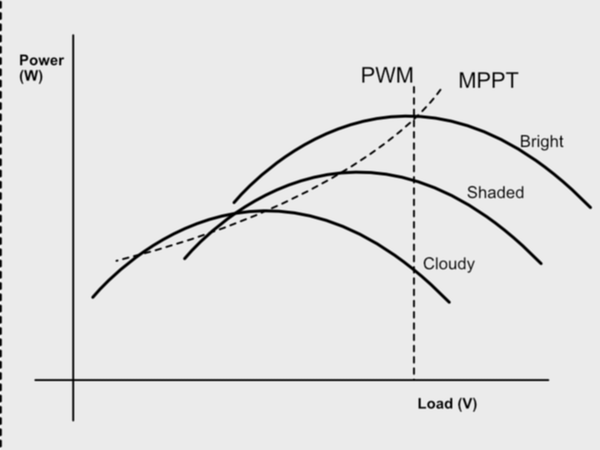When getting started building your off grid system, one of the most confusing and over-marketed components is the charge controller. With nearly equivalent models ranging from $50 to over $200, what do you really need and what can you skimp out on?
What’s the best solar charge controller? Although there can be quite a few factors to consider, in my research it makes sense to spend a little extra to get a MPPT charge controller with good cooling, and solid wire connections. For all but the smallest installations, the money saved by increasing your array voltage (thus decreasing wire size) is worth the upgrade from PWM to MPPT. Further, the biggest difference between controllers is the mechanical quality of their wire connections and cooling, which determine the lifetime of your charge controller.
For my off grid system, I went with the EPEVERR MPPT Solar Charge Controller. The MPPT regulation, incredibly durable construction, and flexible display options made the extra expense over competing cheap plastic “Chinesium” controllers worth the investment for my off grid solar system.

Which is better PWM or MPPT?
On the market today, most charge controllers come in one of two varieties — MPPT or PWM. But what does this mean? For a more in depth explanation of how and why these controllers work differently read to the bottom of the page. In short, MPPT charge controllers are often more efficient and more flexible, but usually cost more, where PWM charge controllers are the cheapest on the market.
Calculating out the costs for a typical off grid solar system, the extra wire expense and solar panel expense incurred by using a PWM charge controller outweighs the cost savings. For this reason, I recommend a MPPT charge controller for off grid systems, in almost every case.
NOTE: if you are considering a very tiny system (less than 1kW) without any long runs of wire, such as an RV solar system, then you might be better of with a PWM controller if you are looking for the cheapest price. However, I still recommend MPPT charge controllers if you can afford the slightly increased price, due to the higher mechanical build quality and overall better product design available in the market for MPPT charge controllers.

Benefits of PWM Charge Controllers
- Generally cheaper for the same size charge controller
- May use less energy to run than MPPT charge controllers
Benefits of MPPT Charge Controllers
- Produces more energy out of the same solar array in some conditions (cloudy, partially shaded)
- Allows you to choose a panel array voltage independently of your battery voltage, which may save wire costs in many off grid solar installations
- Available in higher quality builds
How Big of a Charge Controller Do I Need?
Sizing your charge controller can be a little complex, because it depends on the total power consumption of your system. I’ve written a complete guide to sizing your off grid solar system which covers how to size your components step by step.
However, the simple answers is that you need to size your controller large enough to accept the power generated by your solar panels. The total current supplied by your array can be determined by dividing the power of your solar array by the output voltage of your solar array:
ContollerA = ArrayP/ArrayV
Example: Let’s say you have 10ea 100W solar panels configured as a 12V array (so all in parallel assuming 12V panels). This means you will need roughly an 80 amp charge controller to fully utilize your panels.
However, this is one example when an MPPT charge controller can come in handy. For the same number of panels, if you increase the panel voltage to 24V, you would only need an 40 amp charge controller. And again, if you go up to 48V then you could get by with a much cheaper 20 amp controller. Because MPPT charge controllers don’t need the solar array and battery bank to have the same voltage, you can save a lot of money by increasing the voltage of your solar panel array, but still allow your system to use a more common 12V or 24V battery bank configuration.
What Happens If I Under Size My Charge Controller?
If you have too many panels for your charge controller, most of the time the charge controller will still work just fine. Be sure to check the documentation of your charge controller before you do this, but generally charge controllers will limit the current they supply to within safe limits for their design.
So, on the brightest days, you would probably max out your charge controller and not use the full potential of your panels to charge your system.
However, if you anticipate living in a cloudy or farther north location, you may need substantial extra energy production in the winter vs the summer, and so you could potentially save money by under sizing your charge controller vs the panels, since you will probably produce more energy in the summer than you need anyway. You also have the option of adding more charge controllers later. More on this below.
What Happens If I Over Size My Charge Controller?
Solar charge controllers are sold with a maximum rating in current (amps). If you choose to buy a larger charge controller than you need, you may spend a little extra money, but you should be safe in doing so. Be sure to read the safety documentation that comes with your controller to be sure that it will work in your particular case.
It can be beneficial to oversize your charge controller if you want to be certain to get the maximum power generation possible during bright sunny days. Clear days were the sun is high in the sky may cause solar panels to slightly over produce their rated wattage. So a 100W panel may end up producing 105W or more.
You can also oversize your controller, with the intention of upgrading the number or size of your solar panels in the future. This may save you money over buying a second or larger charge controller at the same time, since doubling the size of your charge controller doesn’t necessarily double the cost.
Can I Have Multiple Charge Controllers in One System
Yes. Contrary to some folk wisdom, you can have multiple charge controllers attached to the same battery bank, but pulling power from different solar arrays. For MPPT charge controllers, this can even be the preferred way to connect the system, since different arrays may have different maximum power points, and by having two controllers you can optimize the total power output of your system.
Before you connect your two charge controllers, be sure they are set to have the same charging profile. For a beginner, the easiest way to do this is to buy two or more identical charge controllers, and make sure they all have the same battery setting input.
How a PWM Charge Controller Works
PWM stands for “pulse width modulation,” which is the method that this controller uses to protect your batteries from over charging. Internally, there is a direct connection between your solar panel array and the battery bank, moderated by a electronic switch inside the controller. The smarts of the PWM charge controller (the micro-controller or dedicated solar charge controlling chip typically) will constantly measure the voltage of your battery bank, and adjust the power output of your panels to match the needs of the system. It does this by rapidly connecting and disconnecting the panels as necessary safely charge the battery bank and provide energy to the system.
If you look at a graph of the energy production of your PWM controlled system, it would look like a series rapid pulses of varying width flowing in to your system from the solar panels. As the batteries charge, the width will get narrower and narrower, until finally the controller disconnects the panels entirely. As you increase the power usage, or the batteries charge again after being discharged at night, the charge controller will increase the duration of the pulses all the way until panels are just straight connected to the batteries.
There are a few draw backs of this approach:
- The panel voltage must appropriate to charge the battery bank, and no higher. Connecting a 24V panel array to a 12V battery bank, for instance, would result in wasting half the power output of your system.
- When the battery bank is near charged, the efficiency of your panels drops considerably because the PWM charge controller leaves the panels disconnected most of the time to protect the batteries.
The biggest benefit of PWM charge controllers are that they are simple to build, and thus relatively inexpensive.
How a MPPT Charge Controller Works
MPPT stands for “maximum power point tracking,” which means that this more advanced controller is designed to get the most power possible out of your panels given varying conditions.
Every panel or array of panels has a power output potential that changes depending on the load being applied to the panels. At just the right combination of voltage and current draw, your panels will produce the most power possible. However, this combination changes throughout the day depending on the Sun’s location and brightness at that particular time.
Included in an MPPT charge controller is extra monitoring and a DC-DC converter. During normal operation, an MPPT charge controller will constantly monitor the power output of your panels and make adjustments to ensure you are producing the maximum power possible (aka tracking the maximum power point).
In order to do this, inside the controller there needs to be a DC-DC converter. This converter not only allows the system to generate optimum power from your panels, but it means that your panel voltage need not be the same as your battery bank voltage. Additionally, DC-DC converters can be highly efficient, over 98% in some cases, and so will not necessarily suffer from a power loss in situations where the battery bank is almost charged. (MPPT charge controllers will limit power output and disconnect the panels if more power is being produced that the batteries and system can handle.)
Benefits of MPPT charge controllers include:
- Separate solar panel voltage and battery bank voltage (frequently saves money on panel wiring and potentially charge controller sizing costs as well).
- More efficient in low light situations and when the battery bank is nearly charged.
- Available in larger sizes and more durable mechanical design (the professional option for controller)
The biggest downside of MPPT charge controllers is their additional cost, but on many systems this can be offset by cost savings in other parts of the system including wiring and controller sizing.
